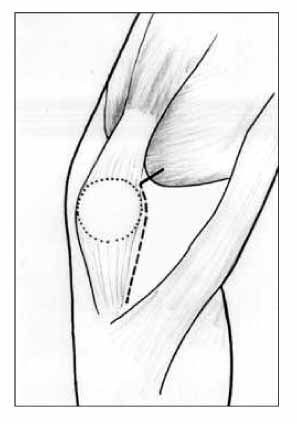J Korean Orthop Assoc.
2009 Apr;44(2):186-191.
Short Term Result of Minimally Invasive Total Knee Arthroplasty with Mini-Midvastus Approach
- Affiliations
-
- 1Department of Orthopaedic Surgery, National Health Insurance Corporation Ilsan Hospital, Ilsan, Korea. hangugi@gmail.com
- 2Department of Orthopaedic Surgery, Yonsei University College of Medicine, Seoul, Korea.
Abstract
- PURPOSE
To investigate the effectiveness of minimally invasive total knee arthroplasty using the mini-midvastus approach through analyzing the short-term clinical outcomes. MATERIALS AND METHODS: Seventy-seven consecutive total knee arthroplasties were performed with the mini-midvastus surgical technique from August 2005 to February 2006 and were followed for more than 1 year after the procedure. All operations were performed with the Nexgen LPS-flex total knee system using a MIS quad-sparing instrument. The evaluation included preoperative and postoperative clinical data, surgical and radiological outcomes. RESULTS: The length of skin incision was average 8.4+/-0.6 cm and the operation time was average 95.5+/-15.7 minutes. The blood loss was average 727.5+/-315.5 cc. The tibial component alignment angles averaged 0.2+/-1.3degrees varus and the tibiofemoral angles averaged 5.8+/-1.8degrees. The mean ROM and the mean HSS score was 117+/-10degrees and 120+/-11degrees, 88.9+/-7.1 and 96.2+/-4.5 at eight weeks and one year after surgery respectively. CONCLUSION: If proper surgical procedures are performed using the appropriate surgical instruments, minimally invasive total knee arthroplasty with the assistance of the mini-midvastus approach, can result in good clinical outcomes and alignment of the implants.
MeSH Terms
Figure
Reference
-
1. Bonutti PM, Neal DJ, Kester MA. Minimal incision total knee arthroplasty using the suspended leg technique. Orthopedics. 2003. 26:899–903.
Article2. Cooper RE Jr, Trinidad G, Buck WR. Midvastus approach in total knee arthroplasty: a description and a cadaveric study determining the distance of the popiteal artery from the patella margin of the incision. J Arthroplasty. 1999. 14:505–508.3. Dalury DF, Dennis DA. Mini-incision total knee arthroplasty can increase risk of component malalignment. Clin Orthop Relat Res. 2005. 440:77–81.
Article4. Fisher DA, Watts M, Davis KE. Implant position in knee surgery: a comparison of minimally invasive, open unicompartmental, and total knee arthroplasty. J Arthroplasty. 2003. 18(7):Suppl 1. S2–S8.5. Haas SB, Cook S, Beksac B. Minimally invasive total knee replacement through a mini midvastus approach: a comparative study. Clin Orthop Relat Res. 2004. 428:68–73.6. Haas SB, Manitta MA, Burdick P. Minimally invasive total knee arthroplasty: the mini midvastus approach. Clin Orthop Relat Res. 2006. 452:112–116.7. Ha CW, Ha HC. Minimally invasive vs. standard total knee arthroplasty: a prospective randomized comparison study. J Korean Orthop Assoc. 2006. 41:841–849.8. Hernigou P, Deschamps G. Posterior slope of the tibial implant and the outcome of unicompartmental knee arthroplasty. J Bone Joint Surg Am. 2004. 86:506–511.
Article9. Laskin RS. Minimally invasive total knee replacement using a mini-midvastus incision technique and result. Surg Technol Int. 2004. 13:231–238.10. Laskin RS, Beksac B, Phongjunakorn A, et al. Minimally invasive total knee replacement through a mini-midvastus incision: an outcome study. Clin Orthop Relat Res. 2004. 428:74–81.11. Repicci JA, Eberle RW. Minimally invasive surgical technique for unicondylar knee arthroplasty. J South Orthop Assoc. 1999. 8:20–27.12. Romanowski MR, Repicci JA. Minimally invasive unicondylar arthroplasty: eight-year follow up. J Knee Surg. 2002. 15:17–22.13. Scuderi GR, Tenholder M, Capeci C. Surgical approaches in mini-incision total knee arthroplasty. Clin Orthop Relat Res. 2004. 428:61–67.
Article14. Tria AJ Jr, Coon TM. Minimal incision total knee arthroplasty: early experience. Clin Orthop Relat Res. 2003. 416:185–190.
Article15. Yoo JH, Han CD, Lee YT, et al. Quad-Sparing minimally invasive total knee arthroplasty. J Korean Knee Soc. 2005. 17:225–233.16. Yoo JH, Han DY, Han CD, Oh HC, Koh IH. Radiological evaluation of quadriceps-sparing minimally invasive total knee arthroplasty. J Korean Orthop Assoc. 2006. 41:454–460.
Article
- Full Text Links
- Actions
-
Cited
- CITED
-
- Close
- Share
- Similar articles
-
- Comparison between the Results of Minimally Invasive Total Knee Arthroplasty Performed with Mini-Midvastus Technique and Quadriceps-Sparing Technique
- A Comparison of the Midvastus and Median Parapatellar Surgical Approaches in Total Knee Arthroplasty
- Comparison of Midvastus and Medial Parapatellar Approach for Total Knee Arthroplasty
- Minimally Invasive Total Knee Arthroplasty
- Comparison of Surgical Approach in Total Knee Arthroplasty: Midvastus and Medial Parapatellar Approaches




